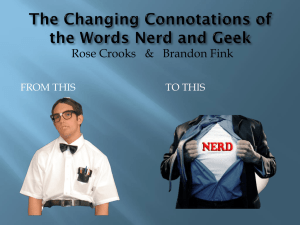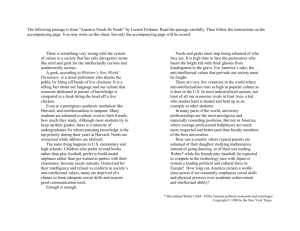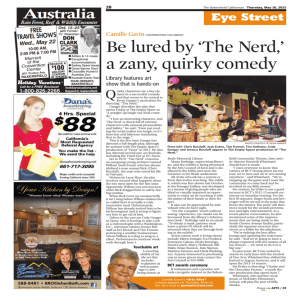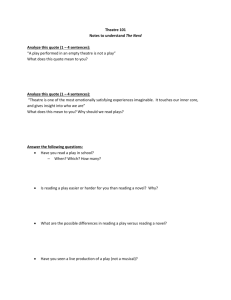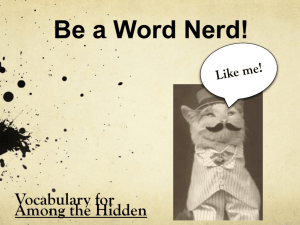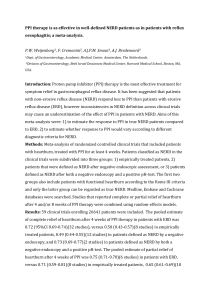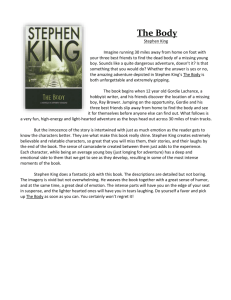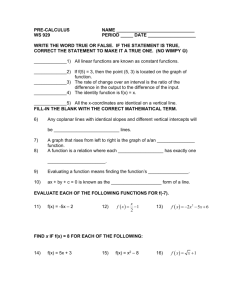Sarah Blumenberg Annotated Bibliography – CMC 200 Bach
advertisement
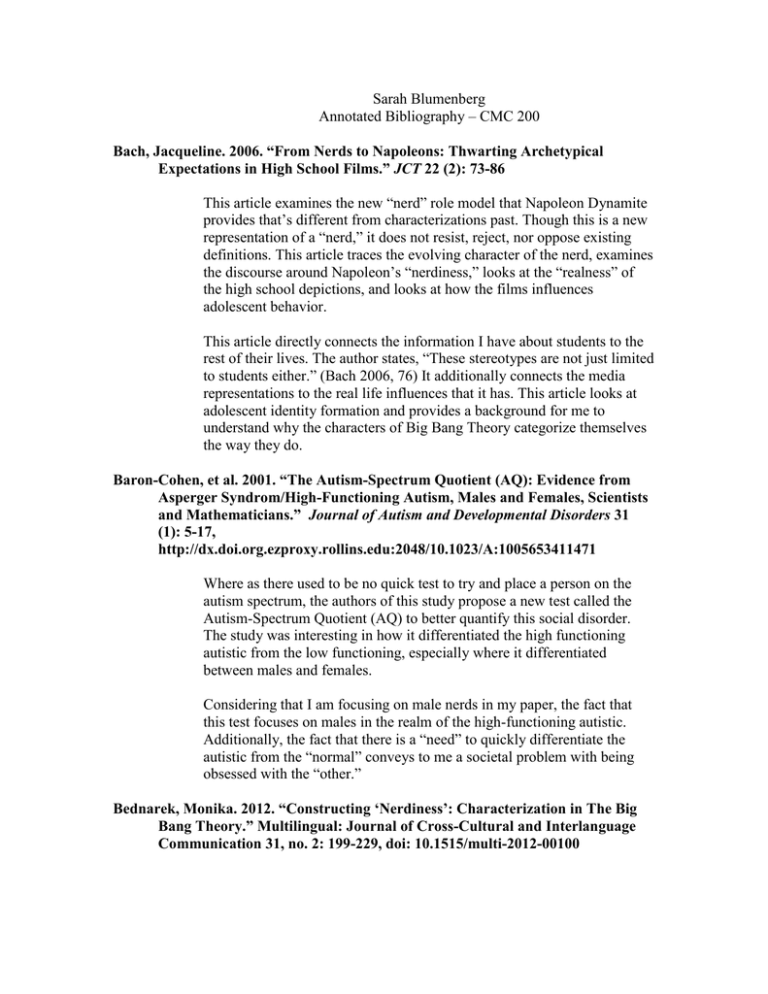
Sarah Blumenberg Annotated Bibliography – CMC 200 Bach, Jacqueline. 2006. “From Nerds to Napoleons: Thwarting Archetypical Expectations in High School Films.” JCT 22 (2): 73-86 This article examines the new “nerd” role model that Napoleon Dynamite provides that’s different from characterizations past. Though this is a new representation of a “nerd,” it does not resist, reject, nor oppose existing definitions. This article traces the evolving character of the nerd, examines the discourse around Napoleon’s “nerdiness,” looks at the “realness” of the high school depictions, and looks at how the films influences adolescent behavior. This article directly connects the information I have about students to the rest of their lives. The author states, “These stereotypes are not just limited to students either.” (Bach 2006, 76) It additionally connects the media representations to the real life influences that it has. This article looks at adolescent identity formation and provides a background for me to understand why the characters of Big Bang Theory categorize themselves the way they do. Baron-Cohen, et al. 2001. “The Autism-Spectrum Quotient (AQ): Evidence from Asperger Syndrom/High-Functioning Autism, Males and Females, Scientists and Mathematicians.” Journal of Autism and Developmental Disorders 31 (1): 5-17, http://dx.doi.org.ezproxy.rollins.edu:2048/10.1023/A:1005653411471 Where as there used to be no quick test to try and place a person on the autism spectrum, the authors of this study propose a new test called the Autism-Spectrum Quotient (AQ) to better quantify this social disorder. The study was interesting in how it differentiated the high functioning autistic from the low functioning, especially where it differentiated between males and females. Considering that I am focusing on male nerds in my paper, the fact that this test focuses on males in the realm of the high-functioning autistic. Additionally, the fact that there is a “need” to quickly differentiate the autistic from the “normal” conveys to me a societal problem with being obsessed with the “other.” Bednarek, Monika. 2012. “Constructing ‘Nerdiness’: Characterization in The Big Bang Theory.” Multilingual: Journal of Cross-Cultural and Interlanguage Communication 31, no. 2: 199-229, doi: 10.1515/multi-2012-00100 This article discusses linguistic deviance and “nerdiness” within Big Bang Theory and the viewers’ perception of the characters as a result. It also discusses why the study of television is useful in the discussion of viewer emotions and how they’re invested in the characters in the parasocial relationships that align them to the people they see on screen. They describe this using a term called “double articulation.” Very specifically, this article characterizes Sheldon and describes the premise of the Big Bang Theory. They use character based analysis and scene based analysis in order to examine Sheldon and his societal implications. I find this article useful because I argue that the double articulation on screen mimics and perpetuates the relation that society has to those they deep to be “nerds.” In discussing the (im)politeness theory connects nicely to the extrapolations I make from my content analysis as it shows the nerd construction to be made of negative social relationships. I find that the stereotypes that this television show illuminates will be interesting to deconstruct in terms of how society views “others” and power relations. Bishop, John H. et al., 2004. “Why We Harass Nerds and Freaks: A Formal Theory of Student Culture and Norms.” Journal of School Health 74, no. 7: 235-251, doi: 10.1111/j.1746-1561.2004.tb08280.x This article examines student reaction to stigmatization with the school setting. It describes the qualities that are socially dominant and those that are socially negative, giving the “nerd” physical identifiers, but ultimately alluding to the nerd’s social stigma. It discusses the relationship between the study behavior and academic behavior and engagement of individual students, the norms and attitudes of close friends, and the peer culture of the institution of school. I categorizes people based on 3 groups within the social hierarchy the jocks, preps, and populars comprising the upper level, the normals in the middle, and the lower level being comprised of freaks, Goths, lowers, druggies, and finally nerds. The authors also examine that it seems as if people in the lower social class system are more accepting of new comers into their caste than those of the upper popularity group. I argue that this stigmatization is mirrored into our television programming that is further reflected back into our societal relationships, perpetuating nerd construction circularly. I also think that this provides a counter argument to those that I make in my paper. I argue that nerds other themselves from upper social groups as they are othered in reverse, where as this paper makes the statement that lower class groups are more accepting of outsiders. Clark, Mark. 2008. “Science Fiction Fandom, Geek Culture, and the Image of the Engineer.” Engineering Studies, http://www.google.com/url?sa=t&rct=j&q=mark%20clark%20engineer%20gee k%20culture&source=web&cd=1&ved=0CDAQFjAA&url=http%3A%2F%2Fw ww.inesweb.org%2Ffiles%2FClark.doc&ei=vF2FUZvuMpDA9gTu84GICQ&u sg=AFQjCNFNxG04JGFGObqoOWcBDRwZJGYzHA&bvm=bv.45960087,d.e WU This article looks specifically about the construction of the engineer in terms of identity and how they perceive themselves. This article overtly connects “geek culture” to technological advancement. It extrapolates that an engineer’s social image is assumed to reflect his professional status. It makes the assumption as well that this is a male specific societal role. I find this useful as it connects “geek culture” to professional achievement. Additionally, the character Howard it an engineer in the Big Band Theory and is the only one of the 4 “nerd” men to not have a Ph.D. Additionally, this provides a counter argument to the one that I am making in this paper. This is arguing that “geek” culture is about identity and personal technological skills, not about social relations. Cross, Tracy L. 2005. “Society’s Evolving Stereotypes of Our Students With Gifts and Talents.” Gifted Child Today 28 (4): 26-27, 65 http://www.eric.ed.gov/ERICWebPortal/search/detailmini.jsp?_nfpb=true& _&ERICExtSearch_SearchValue_0=EJ720371&ERICExtSearch_SearchTyp e_0=no&accno=EJ720371 This article discusses the link between being intellectually “gifted” and the terms “nerd” and “geek.” This article also makes the distinction between nerd and geek. Where these are both socially derogatory terms, the term “geek” is far worse. “Geeks,” additionally, are more connected to their technological knowledge rather than just being “gifted.” Also, you can positively spin these terms in regards being experts to using their technological expertise as “helpers” when their talents intersect with mainstream people. Because of these, the term “nerd” has come to be more socially neutral. People can be nerds and still succeed. Additionally, being a nerd is a choice about behavior and how one portrays themselves, and less of an ascribed attribute, and is something you can more or less grow out of. I think by distinguishing between the “nerd” and the “geek” better allows me to socially categorize the men in the Big Bang Theory. This would better explain why some of the men are more socially stigmatized than others. On top of that, men can have the “nerd” stigmatization while still succeeding socially within their confines. Engelhart, Jasmine. 2012. “The Nerd as the Other.” http://files.combinatori.at/univie/ps_paper_freak_shows/the_nerd_as_the_ot her_by_jasmin_engelhart.pdf This paper examines the American “nerd” in terms of the American “freak show.” The author uses a discourse analysis to examine how people are “othered” within popular cultural, specifically looking at the television shows “The Big Bang Theory” and “Beauty and the Geek.” These representations implicate on masculinity, sexuality, and societal norms. These shows other the nerd so that they can be laughed at as they exhibit “inept.” This article shows all the ways in which a nerd is constructed in media and then discusses how this is exhibited in the Big Bang Theory. Some of these constructions include white, male, heterosexual, intelligent, and physically unattractive. These characteristics are exaggerated when the nerd is contrasted against someone who exhibits behavior of a “non-nerd,” which in my case would be Penny contrasted against the male nerds. Holderman, Lisa B. 2003. “Media-Constructed Anti-Intellectualism: The Portrayal of Experts in Popular US Television Talk Shows.” The New Jersey Journal of Communication 11, no. 1: 45-62, doi: 10.1080/15456870309367437 This article explores how society perceives expertise in a talk show field and how that constructs a society of anti-intellectuals. Though experts in a particular field have an obvious intellectual advantage, socially crowds value their own experiences above that of the expert. Being a “nerd” challenges the social order and threatens the power structure. It, like many other articles, gives us a list of stereotypical nerd representations. This article makes the distinction between intellectual and non-intellectual experts and how the crowds perceive them. As “nerds” and “geeks” gains prestige in that it signifies expertise and what it brings to mainstream society. The quote that I find most interesting for the use of my paper is “Cultivation theorists assume that television, in particular, both selectively mirrors and leads society and that patterned representations and narratives on television operate as a form of social control and status quo maintenance.” I take this to mean that the representations of nerds on television perpetuates the social order in which they exist, giving the people who have the most potential for social change the least power. Kendall, Lori. 2011. “ ‘White and Nerdy’: Computers, Race, and Nerd Stereotype.” Journal of Popular Culture 44, no. 3: 505-524, doi: 10.1111/j.15405931.2011.00846.x This article discusses the depiction of the marginalized nerd identity as closer to hegemonic masculinity by using things like computer expertise to exhibit prowess, to show the contradictions inherent in nerd identity. It examines the construction of the “nerd” to reveal signifiers of whiteness and male gender as basic elements. It examines “nerd” subculture called “nerdcore,” incorporating elements. The premise of this article is to show how the nerd operates within today’s culture and how our society’s reliance on computers and our attitudes towards those fluent in this technology intersect to implicate on power relations. Kendall does this by analyzing the Geek Squad Website, Weird Al’s “White and Nerdy,” and the subculture of “nerdcore.” I find this article relevant to my project because it examines the nerd within the scope of masculine power. Considering that in my paper I argue that the label of “nerd” is a social vehicle, rather than ideological, that is used to both other and self-other, I think that putting this in terms of stereotypical definitions of hegemonic masculinity would be quite useful. I also think that putting the “nerd” stereotype in terms of pop culture references and real-life examples is useful as it examines the construction outside of the realm of television. Lagerfeld, Steven. 2004. “The Revenge of the Nerds.” Wilson Quarterly 28, no. 3: 2834, http://connection.ebscohost.com/c/literary-criticism/13876379/revengenerds This article examines the “cognitive elite” as we generally define by highIQ’s. It examines the societal inequalities inherent in delineating between people based on a test that changes frequently. How we quantify intelligence has inherent structural problems. Lagerfeld discusses the privilege inherent in being part of the “high-IQ” group. The fascination with “smart” people perpetuates the exultation of specialized instead of general knowledge. Furthermore, high intelligence does not necessarily correlate to leadership ability. This article connects the most to my arguments about intelligence perception in that it discusses individualism (and thus lack of social interaction) and intelligence types. It discusses emotional intelligence as an equally useful quality of the human brain. I think that this will be useful in my discussion of Penny in contrast to the emotional construction of the nerd. Murray, Noel. 2013. “The Changing Face of “Nerds” (and Autism) in Popular Culture.” The A.V. Club. http://www.avclub.com/articles/the-changing-faceof-nerds-and-autism-in-popular-c,91151/ This article provides a physical explanation of a link between “nerds” and the autism spectrum, which is often alluded to in the discussion of nerds, but not overtly referenced. He makes a points to premise his argument with the first being that not every geeky person is autistic and the second being that as a member of the dominant social hierarchy, it is okay to find the autistic funny. The author, having an autistic son, links many of the stereotypical traits of “nerds” to those of people who are on the autism spectrum, and that by joking about these “nerds,” at least we see that these types of people exist in society. I think this article is relevant in that it explains that there is a possibility that nerds are being more culturally relevant because they may be becoming more socially accepted and are becoming less marginalized. The nerds of society are gaining more public attention and evolving their stereotypes. I think that part of my social relevance that I want to bring to my paper so that it touches the reader is the idea of autism and it’s social stigma. Varma, Roli. 2007. “Women in Computing: The Role of Geek Culture.” Science as Culture 16, no. 4: 359-376, doi:10.1080/09505430701706707 Varma discusses the immensely underrepresented sub-sub-culture of female geeks. Within a culture in which the nerd is already subjugated, the female nerd is seen as incompetent by comparison, making it harder for women to go into computer-related careers. This article also makes the distinction between “nerd” and “geek,” also constructing the geek as significantly worse of a title. Part of these titles’ stereotypical construction is that it is embodied by white males, implicating on people of color and women. Varma discusses the concept of myth and how it perpetuates (often overtly false) hegemonic values in order to meet the ideological agendas of those in power. Considering that in my paper I am focusing on male nerds, this article both provides useful definitions about what it means to be one of those types of nerds and what feminine nerds are by contrast. The nerd construct, in it’s essence” is comprised of masculine-dominant traits like rational, empirical knowledge, and the ability to secure the American Dream. Zhu-hui, Yin, and Yun Miao. 2012. “Rhetorical Devices in Dialogues of The Big Bang Theory.” Sino-US English Teaching 9, no. 6: 1220-1229, http://www.davidpublishing.com/davidpublishing/Upfile/7/23/2012/20120723 82010977.pdf This article examines the effectiveness of rhetorical devices within The Big Bang Theory on learner awareness and appreciation of literary works. This work also examines characterization of the people within the show. It uses dialogue analysis to implicate how episodic narrative construction uses devices such as irony, sarcasm, and parody further the construction of the characters while simultaneously effecting viewer literacy and language skills. Whereas in this paper I’m not examining the show’s effect on people who embrace English as a second language, it is interesting to me to see these “American” characters categorized by authors who were not raised with the same hegemonic values as the assumed audience of this show. This article more primarily defines the show to describe it to a non-viewer, which is helpful from an objective standpoint. It is also heavy in characterization, so that is especially helpful in discussing my textual analysis of the Pilot episode and how it characterizes.
